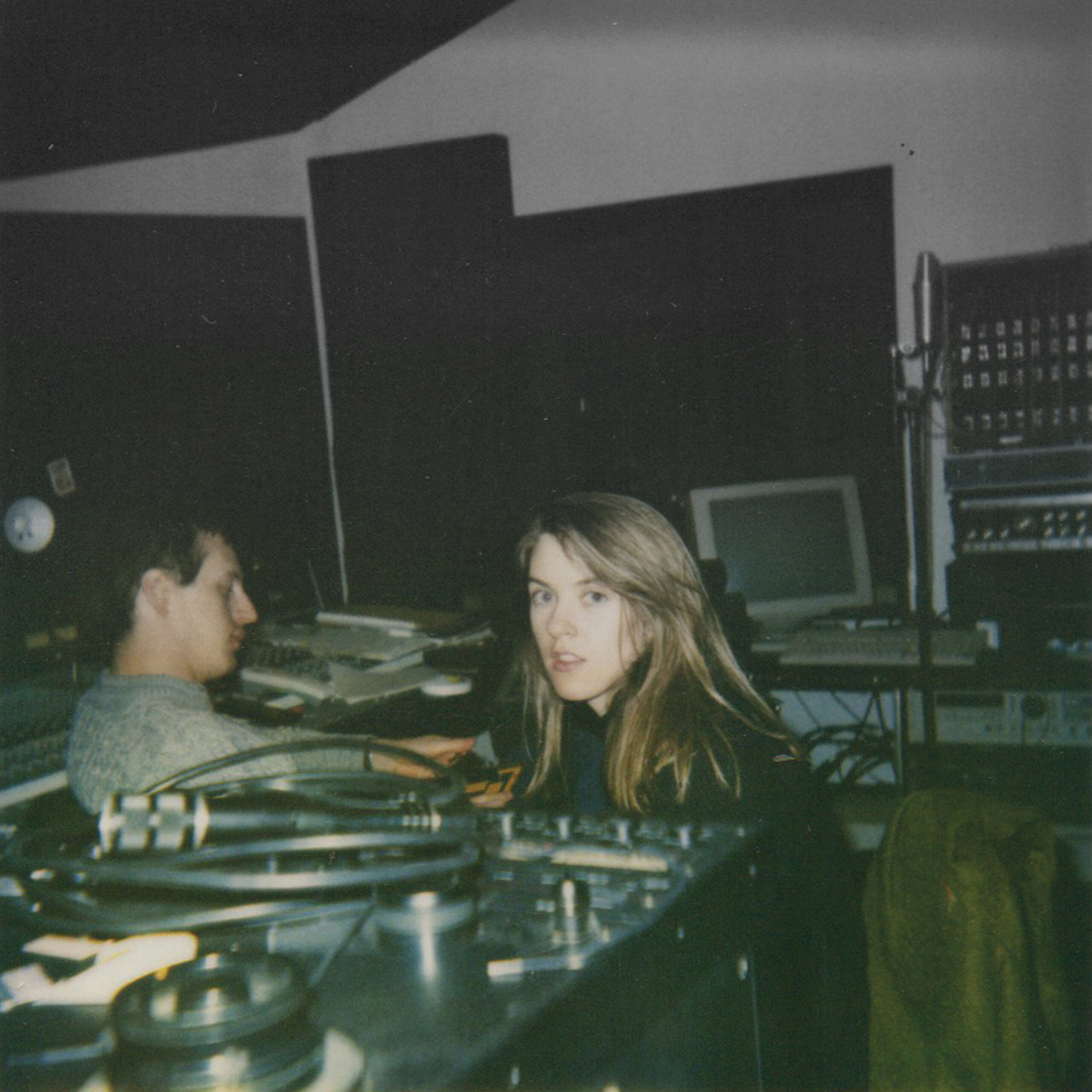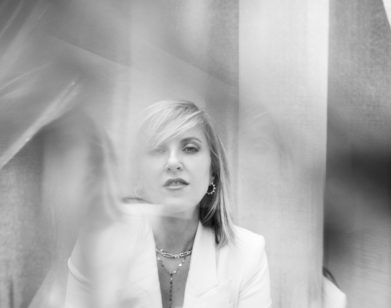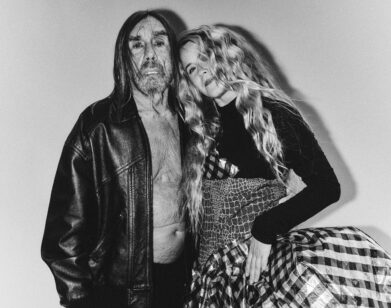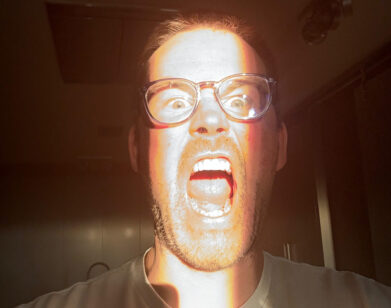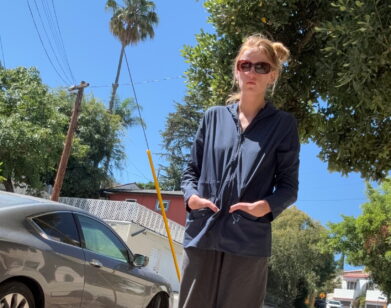NOSTALGIA
“It Was Minutely Personal”: Liz Phair Looks Back on 30 Years of Exile in Guyville
Over three decades ago, Liz Phair picked up a guitar and recorded Exile in Guyville, a biting, raw, lo-fi rock exploration of desire and power that travels through speakers like the words of a close friend. “We had an abundance of it when we were young, and we would have given anything to get rid of it,” Phair told visual artist Natalie Frank, who designed visuals for the upcoming tour, of the radical vulnerability required to make such an album. “And now it’s like, ‘Oh my god, if I could just blush!’”
Preparing for the 30th anniversary tour of her debut, Phair is, in many ways, a different person than the 20-something who made a name for herself in the ’90s Chicago music scene, beguiling—and scandalizing—listeners with brash lyrics like “I’ll fuck you ’til your dick is blue.” Now, the rock star has been combing through old recordings made during the pandemic, while Frank is departing from her past work inspired by the writings of Ovid and Brothers Grimm to create intimate portraits of her loved ones. Ahead of the tour, which kicks off in California next week, Phair talked to Frank about using fairy tales to reclaim phallocentric history, the outrageous women that have inspired them along the way, and what it’s like to revisit Exile in Guyville.—EMMA SCHARTZ
———
NATALIE FRANK: Hi.
LIZ PHAIR: Hey, how’s it going?
FRANK: Wow, I love that you have my book back there. Thank you.
PHAIR: It’s so gorgeous. Have you seen any of the footage yet? The mockups with your paintings on the buildings were just incredible. It’s almost like your work has become the soul of the [show’s] theatricality. It’s just beautiful.
FRANK: Oh, I love that. Well, I feel like I’ve been channeling your work for 30 years, so this feels appropriate.
PHAIR: Your painting style, the gestural quality of your brush strokes and the expressiveness of your figuration, it felt instantly musical to me. I’m like, “Oh my god, it’s music in paint.” Your paintings, they’re a composition, but at the same time the eye can follow around and find these beats and little sections where a theme is echoing. Not even to get to the fact that we both are attracted to dystopian fairy tale imagery and reclaiming girlhood images and from the woman who now understands what was beneath it.
FRANK: I love that. When did that idea of wanting to reclaim some sort of fairy tale start for you? I know, for me, they’re kind of archly feminist, and it’s about digging back into history, finding overlooked women, and giving them a visual voice.
PHAIR: Well, what you last just said about giving women a voice started in college because even my art book, assigned by a female professor, a pretty definitive, door jam of a book, and there just weren’t women artists in it, to an egregious degree. Where I’m like, “Anybody? Anybody?” And I had been a feminist before that, through my mother, who went to Wellesley, but I had not had my own moment. I could have been wearing acid-washed jeans with little flower decals, for real. But I knew what I needed to do and that has stuck with me ever since. So much has been documented in human history and so little [of it] has concerned the contributions of women. It needed to stop with my life immediately, but it also needed to be encouraged and rectified.
FRANK: Right. What kind of things were you reading at the time? For me, I remember it was Story of O—I did a show based on Story of O that ended up being censored by a woman who thought my drawings would traumatize other women. But I remember reading that book and feeling like, “Yes, I grew up in the south. Yes, my headmaster told me I was a pornographer and tried to expel me from school for many years, but this is not how I feel on the inside.” And that book unleashed my world. Did you have a similar kind of thing?
PHAIR: Have you heard of The Mists of Avalon? It was a retelling of the Arthurian legends from the point of view of his half-sister, Morgaine, and I had been interested ever since [I read] The Once and Future King, and having lived in England and seeing all the ruins. They really made an impact on me. And the histories of the lives of women were so horrific. The opportunities to advance yourself or pursue anything of your own volition was pretty much nonexistent. Just to feel the sense that we can reclaim how influential and important women have been throughout history if we go looking, if we put the stories together from the artifacts or whatever’s left behind. I really related to the fact that women are the domestic workers in a way. We’re always putting things back together and keeping the house going. Well, we can do that in history. We can clean it up and make the stories live again.
FRANK: That’s interesting. I don’t know if you’ve read Marina Warner, she writes about the history of fairy tales and folktales in relation to women and the images of women that resulted to try to control fears about what women could do. So in our book, it was really important for me to put in the families of the women who originally told these stories, because their names have been erased by history when the Brothers Grimm cleaned up the stories and put their own name on them.
PHAIR: Did you explore the Pagan traditions? There’s some scholarship right now about William the Conqueror coming in 1066, or something. The Romans were more inclined to leave the Pagan traditions alone to some extent, whereas the policy of the Christians coming in basically wiped clean a lot of the Pagan tradition, which was more female-centric.
FRANK: Yeah, it’s fascinating. That was the subject of Jack [Zipes’] and my second book on the “Sorcerer’s Apprentice.” I didn’t know anything about this, but he looks at this tale of a “Sorcerer’s Apprentice,” who is actually like a humiliated and rebellious apprentice. Of course, we don’t hear about the rebellion because people really don’t want to encourage young people to rebel. And in Ovid, just as you were saying, it starts out with women shape-shifting. But after Christianity, that became too threatening. So all of the roles of women shape-shifting were excised and the men got to be the shape-shifters.
PHAIR: And that would have been seen as a very powerful woman at one point, the shape-shifter, and now it was demonic and witchy.
FRANK: Absolutely. Do you feel like a shape-shifter in your music and your work?
PHAIR: Honey, I would shape-shift all day if they’d let me. I would love to shape-shift more. One of the things that I did early on that pissed everybody off was switching up genres, trying different things out, which I find really rewarding. It may not produce masterpiece level work all the time, but for me, if I cannot fluidly move through growth and get my hands dirty in the process, nothing that I gain is ever solid or lasting.
FRANK: I love that. Have you always been that type of artist?
PHAIR: I’ve always been that kind of explorer. “What’s over here? What’s in here?” But I think one of the things I noticed in your artwork and my songs is the complete freedom to take the past and decide that it’s your tool to play with. What I feel that women have gained primarily from this era is the safety to do so. So I’m going to grab it and use it with both hands for as long as I’m able to.
FRANK: I think that sense of play is an important kind of enabler of freedom. My mentor, this British-Portuguese artist, Paula Rego, I was in her studio one day and she was like, “You should really look at the Grimm’s fairy tales and draw.” I had never worked from literature and I had never drawn before. And that’s when I started to draw and I kind of stopped painting. It led to all these other avenues of performance, design and books, and it’s been so rewarding. And writing, too. I know you’re a wonderful writer. I really enjoyed your first book.
PHAIR: Horror Stories, yeah.
FRANK: Yeah, Horror Stories. And just the idea of using your voice in as many media as possible. Are there visual artists who’ve been really important to you?
PHAIR: I was in love with Nancy Spero’s work, who I interned for, the kind of appropriation of classical figures. She worked with prints and paint, but she basically designed using figurative forms from antiquity that were female and placing them in the situations that she considered male-created, like the Vietnam War, and having these beautiful, linear, forms of naked women just tumbling over these violent scenes of explosions, of helicopters. I was just blown away.
FRANK: How did you find your way to those artists?
PHAIR: You know, I’ve been a lifelong write the passionate letter person. So if I admire someone, I will write the letter and just tell them what their work means to me and sometimes ask them for a job. They didn’t have to pay me, so I guess it was easier to say yes.
FRANK: My first year out of college, I worked for the curator of modern and contemporary art at the Met, Nan Rosenthal, who was the biggest character, and she was the Jasper Johns and Robert Rauschenberg scholar. She was an inveterate chain-smoker and scotch drinker and had no sense of propriety. My office was down the hall, whatever she needed, she called it a hoo-ha. And she would just scream. She would sit in her office, which was like a broom closet, shut the door, and tell me all this gossip about all of the famous abstract expressionists she had slept with.
PHAIR: Slept with!
FRANK: And she would just chain-smoke in my face and get the Dewar’s gallon out every day at 3:30, which is when work stops. I learned so much from her. It was that very special generation of women who were like, “We know what it takes to succeed at this level and we’ve earned it, so get the fuck out of my way.”
PHAIR: If you survived the ’70s and ’80s in the art world in New York, you were a soldier. You were a veteran.
FRANK: Yeah. Wow.
PHAIR: You know, we need those characters. I was so inspired by characters when I was younger. What was so frightening about adult life was how regimented it felt, how inevitable it felt. And I wasn’t willing to sacrifice my one existence. It’s just such an orderly and unproblematic realm. It’s mapped. So the people that I met in the art world just blew that apart and opened so many options.
FRANK: Was the Exile in Guyville a response to that feeling?
PHAIR: It was minutely personal. It was one-hundred percent an intimate exercise. It was everything I wanted to say to the guy I had a crush on who could so seamlessly fit into the lyrics that Mick Jagger was singing. I couldn’t even believe it. It was like it fit perfectly, the arguments we would’ve had. So it was almost like a schoolgirl fantasy mixed with a very serious art project. Isn’t that what we do all the time? We take a childhood obsession and then, as mature people, turn into something professional.
FRANK: Do you have a favorite song on the album?
PHAIR: It switches all of the time, and that’s a pretty good endorsement for the album itself and the writing within it. Right now, I’m interested in the way I did “Girls! Girls! Girls!” and the way I had myself shout. I was like, “Okay, Brad, here’s what we’re going to do. I’m going to be doing a normal vocal and then I’m going to be like 10 feet away, like some heckler in the crowd, shouting this nonsense.” So the backing vocal is actually me. And it’s just bullshit. It’s just sort of John Hughes-ian Home Alone-esque Macaulay Culkin bullshit in the back, but it’s evocative of the bar singer. I don’t know, I just love those details. To be free, to be inventive and silly and scary and inappropriate and sexual and confrontational about things that were traumatic for you. To let society know, where they would much rather you keep it to yourself . I’ve never found a way to acquire any other way of truth-telling.
FRANK: Are you writing new music now?
PHAIR: You know, what I have musically right now are songs that I wrote previously but ignored. I’m resurrecting those and it’s fascinating, going through the files and discovering old stuff that I have finished over the last pandemic, really.
FRANK: That’s so beautiful.
PHAIR: How about you? After this project, what’s going on?
FRANK: I’ve been painting, working on large-scale portraits of people around me, creative friends, but kind of stripping away all the artifice from the drawings and letting myself be comfortable painting vulnerability. Even that sentence makes me cringe. But just looking at the portraits and letting the people speak for themselves in a way.
PHAIR: I love it.
FRANK: I’m really excited for the show. Can you kind of foretell what it’ll feel like for you to play this album?
PHAIR: I mean, I don’t know how I’m going to feel. It’s going to be exciting. My goal is to soak up every moment of it. That’s the benefit of being older, that you can actually program yourself to do that. You can be like, “Don’t miss any of this.” So I’m really going to look forward to that. But there’s something bittersweet too, because I can’t help but think about my entire career and the totality of it. There’s a weird, circular effect of a 30-year anniversary that feels the human lifetime hasn’t changed that much over the centuries. It has a little bit, but we get as much time as we get. So a 30-year career seems to be indicative of a happy, successful life. And this album, which was so personal and so private—when you said intimacy, and how you’re really looking for vulnerability—I could not agree more. We had it in abundance when we were young, and we would have given anything to get rid of it. Like, “Please don’t make me so self-conscious. Please don’t make me so afraid of vulnerability. That awkward conversation is going to haunt me for months. I’ll never talk to that person again.” And now it’s like, “Oh my god, if I could just blush!” Or be genuinely embarrassed. Do you know what I mean?
FRANK: Yeah, I do. I mean, I blush a lot, so it’s one of my fears that I’m always turning bright red, especially around boys.
PHAIR: Well, as a parting gift for this interview, can I please have some of your blushing? Will you give me some of your embarrassment?
FRANK: Absolutely. You can have it all.
PHAIR: Thank you.

